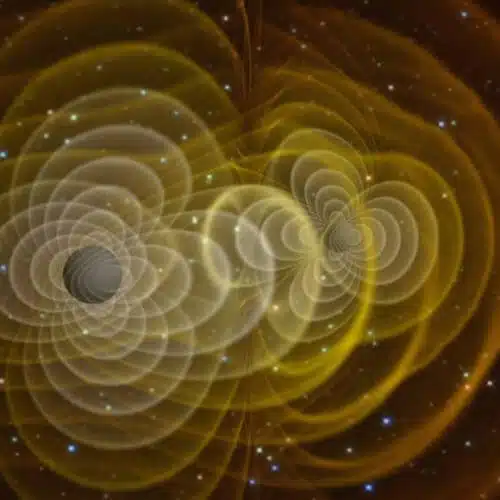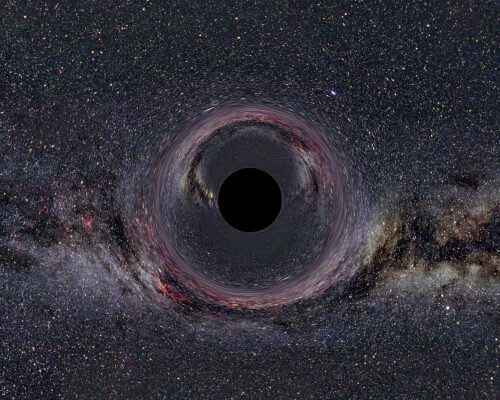In late 2018, researchers at the LIGO gravity observatory announced that they had identified the most distant and massive source of space-time ripples ever observed: waves created by pairs of colliding black holes in deep space. Only since 2015 have we been able to observe these invisible astronomical bodies, which can only be detected by their gravitational pull

Author: Carla Rodriguez Almeida
Postdoctoral fellow, Max Planck Institute for the History of Science
In late 2018, researchers at the LIGO gravity observatory announced that they had identified the most distant and massive source of space-time ripples ever observed: waves created by pairs of colliding black holes in deep space. Only since 2015 have we been able to observe these invisible astronomical bodies, which can only be distinguished by their gravitational pull.
The history of the hunt for these mysterious objects dates back to the 18th century, but the decisive phase took place in the darkest period of human history - World War II.
The idea of a body that captures the light and thus becomes invisible to the rest of the universe, was first used by the natural philosopher John Mitchell and later also by Pierre-Simon Laplace in the 18th century. They used Newton's laws of gravity to calculate the escape velocity of a particle of light from a body, and predicted the existence of stars so dense that even light cannot escape them. Mitchell called them "dark stars".
But after the discovery that light had a wave form in 1801, it was unclear how much light would be affected by the Newtonian gravitational field, so the idea of dark stars was dropped. It took about 115 years to understand how light as a wave would behave under the influence of a gravitational field. The realization came when Carl Schwarzschild solved the problem a year after the 1915 publication of Albert Einstein's general theory of relativity.
Schwarzschild also predicted the existence of a radius beyond which light could not cross and it is called the Schwarzschild radius after him. The idea was similar to Mitchell's, but now this critical radius was seen as an impenetrable barrier.
It was not until 1933 that George Lameter showed that this impenetrability was only an illusion of a distant observer. Using the famous illustrations of Alice and Bob, the physicist assumed that if Bob stood still while Alice jumped into the black hole, Bob would see Alice's figure slow down until it reached the Schwarzschild radius. Lameter also showed that in reality, Alice crosses the barrier: Bob and Alice simply experience the event differently.
Despite this theory, at the time there was no known object of this size or even anything approaching a black hole, so no one thought anything like Mitchell's dark stars could exist. In fact, no one dared to even take this possibility seriously until World War II.
From dark stars to black holes
On September 1, 1939, the Nazi German army invaded Poland, starting the war that changed world history forever. Amazingly, on that very day the first academic paper on black holes and the continuation of gravitational contraction was published. The article was praised. The publication of the paper, written by John Robert Oppenheimer and Hartland Snyder, two American physicists, was a decisive point in the history of the study of black holes. This timing seems especially strange when we know the centrality of the development of the theory of black holes during the war years.
This was Oppenheimer's third and last paper in astrophysics. He and Snyder watch it as the continued collapse of a star under the influence of its own gravitational field, until an object is formed with such enormous gravity that even light cannot escape. This was the first version of the modern concept of a black hole, an astronomical body so massive that only its gravity would be discernible.
In 1939 black holes were still considered too strange to believe. It would take another two decades for the idea to be developed enough for physicists to begin to understand the implications of the continued contraction described by Oppenheimer. World War II itself played a crucial role in its development, because of the US government's investment in atomic bomb research.

Reborn from the ashes
Oppenheimer, of course, was not only an important figure in the history of black hole research. He later headed the Manhattan Project, the research group that led to the development of atomic weapons.
The politicians understood the importance of investing in science to bring military benefit. As a result, all over the world, there was extensive investment in revolutionary physical research related to war, nuclear physics, and the development of new technologies. Many physicists devoted themselves to research in these fields, and as an immediate result, the fields of cosmology and astrophysics, including Oppenheimer's article, were largely forgotten.
Despite the decade lost to large-scale astronomical research, physics as a whole prospered as a result of the war—in fact, military physics advanced astronomy as well. The USA ended the war as a center for the study and research of modern physics. The number of doctoral degree recipients increased, and a new tradition of postdoctoral education was established.
With the end of the war, the study of the universe was renewed and it was a renaissance period for the theory of general relativity. The war changed the way physics research was conducted, and ultimately, this process led the fields of cosmology and general relativity to receive the recognition they deserved. This was the basis for the acceptance and understanding of black holes.
Princeton University has since become the center of a new generation of relativity researchers. There the nuclear physicist, John Wheeler, who coined the name "black hole", returned to investigate general relativity, and re-edited Oppenheimer's work. At first he was a skeptic, but the influence of relativists around him, the new advances in computational simulation and radio technology - developed during the war - made him the biggest fan of Oppenheimer's prediction from the day the war broke out, September 1, 1939.
Since then, theories have been developed explaining the existence of many types of black holes and other objects, but it was only in 2015 that the search for direct evidence of the existence of black holes bore fruit. The measurement of the gravitational waves created in a system where two black holes collide was the first concrete proof of the existence of black holes.
For the article in THE CONVERSATION
More of the topic in Hayadan:

2 תגובות
Finally seeing cosmology articles in a direction other than dark matter.
Eric Verlind claims for about a decade that quantum entanglement is the cause of gravity, and the change of gravity depends on the distance scale and not just Newtonian.
The material is the void and the space is the full and in it the vibrations which are the light or radiation. And that solves the merger